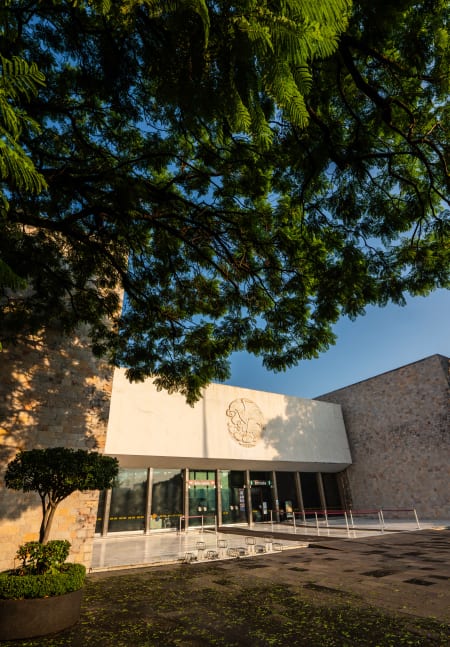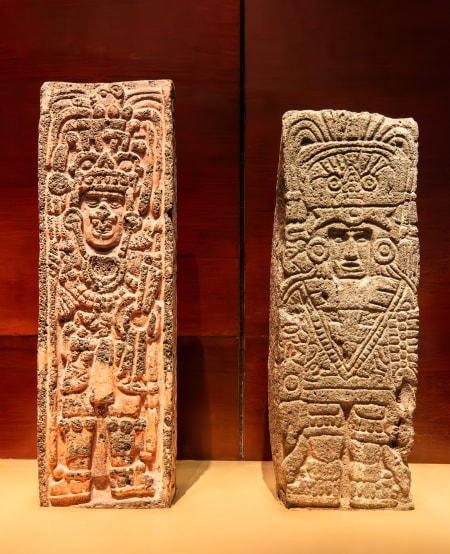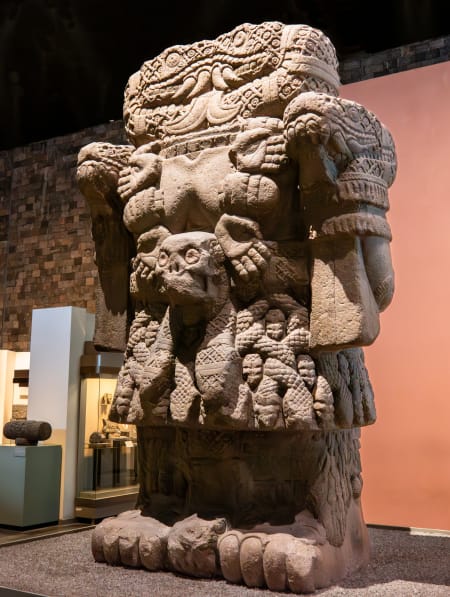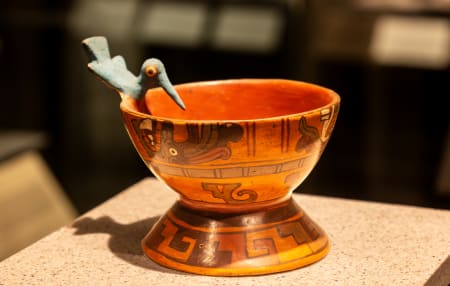The Story of Ancient Mexico
500 years ago, when the Spanish conquistadors first set foot on Mexican soil, they encountered a land that was already home to rich cultures, great cities, and powerful empires.
The history of this region, known as Mesoamerica, has captivated people across the world ever since. Over the centuries, archeologists have painstakingly pieced together the stories of the great civilizations that once ruled these lands. The ruins of ancient cities, works of art, codices and sculptures, all shed light on the mysteries of cultures that conquered swathes of territory and built political and economic power bases, but in many cases also suffered dramatic and abrupt collapse.
Mexico’s National Museum of Anthropology offers an unparalleled exploration of the societies that inhabited Mesoamerica before the Spanish conquest. The complex history of the Central Highlands is told with expansive collections covering the distinctive cultures that rose to power over the centuries: Teotihuacán, the Toltecs, as well as the Aztec Empire whose capital, Tenochtitlan, left the conquistadors in awe.
The rich and varied cultures of Mexico’s regions are covered in detail: from 3,000 year old sculptures produced by the Olmecs, to the Zapotecs of Oaxaca and the kingdoms of the Maya. The story of Mexico’s indigenous groups since the Spanish conquest is also told, with the upper floor of the museum examining the cultures that have survived and flourished to this day.
This is a vast museum representing the full breadth and scope of Mexico’s pre-Columbian past. It can therefore be a little overwhelming for first-time visitor. This guide aims to condense down this expansive history, walking you through the museum room-by-room. We will introduce each culture, tell the story of the civilization, and draw your attention to some of the most remarkable archeological findings on display. We hope this will enrich your understanding of these enthralling periods of Mexico’s history.

Rooms 1 & 2: Introduction to Anthropology
The museum opens with an introduction to anthropology and the arrival of humanity in the Americas, setting the scene for the stories of Mexico’s pre-Columbian civilizations which are told in the rooms that follow.
These rooms recount the early evolution of human beings, their arrival in the Americas across the frozen north and their journey southwards to populate the continent. The displays explain how the development of agriculture enabled the rapid growth of the human population.
Some of the oldest archaeological discoveries in the Americas are exhibited here, with sculptures and spear tips dating back to the prehistoric period.
Room 3: The Pre-Classic Period
The museum’s focus then moves on to the Central Highlands: the region centered on Mexico City, encompassing the present-day states of Puebla, Morelos, Tlaxcala, Estado de México and the south of Hidalgo.
Bordered by the Sierra Madre mountain ranges to the east and west, and a range of volcanic mountains to the south, this was a highly populated region from where powerful societies would build a political and economic sphere of influence across Mesoamerica.
During the Preclassic period (around 2,300 BC to 100 AD), the development of agriculture transformed the region from a nomadic hunter-gatherer society to one of settled, sedentary communities. Room 3 charts how society progressed over this period.
Ceramic production flourished and the room is filled with artifacts from this time. Villages were established and architecture developed with the construction of temples, ceremonial centers, and ball courts.
Religion became institutionalized, centered around gods and priests rather than shamans. A large reproduction in the room of a typical home with a burial site underneath demonstrates how sophisticated religious rituals began to emerge during this period.

Room 4: Teotihuacán
Mesoamerica’s earliest great city, Teotihuacán, emerged in the first century AD to become a political and economic powerhouse. This room explores the growth of this remarkable society which prospered for centuries until a dramatic decline around 750 AD.
With an economy based around the mining and production of obsidian goods and pottery, Teotihuacán became the center of a trading network that spanned Mesoamerica. Its economic might and importance as a religious center led to the construction of the giant pyramids of the Sun and Moon, the ruins of which can be seen today just an hour’s drive from Mexico City.
This room is filled with artifacts retrieved from the ruins of Teotihuacán, including ceramics, masks and objects made from obsidian. The most striking object, the Disk of Mictlāntēcutli, was most likely left by the Aztecs centuries later, for whom Teotihuacán held great spiritual importance as the site of the creation of the Fifth Sun.
Several large reproductions showcase the fine artistry in the design of the pyramids, and in the gardens outside, a large model maps out the geography of the city.

Room 5: The Toltecs
The demise of Teotihuacán left a power vacuum across central Mexico. Over the following centuries, various smaller city-states would compete to takeover Teotihuacán’s lucrative trade routes.
This period, known as the Epiclassic (650 – 900 AD), was a time of conflict and political instability within heavily fortified urban centers. No city-state would gain regional hegemony until the Toltecs, a highly militaristic society, rose to power in the Early Postclassic period (900 – 1250 AD).
This room’s highlight is the central hall dedicated to the Toltecs. It is filled with giant statues and smaller artifacts recovered from their capital Tula, in Hidalgo. The Toltecs rose to power at a time of conflict and were an extremely militarized society. Many of the statues and artifacts are linked to warfare, seen most prominently in the imposing 15-foot high Atlante statue that depicts an idealized Toltec warrior.
This room also explores the smaller city-states that battled for dominance in the Epiclassic period prior to the rise of the Toltecs. These include Xochicalco, Cacaxtla-Xochitecatl and Cantona. Similarly, it ends with two city-states that prospered in the Postclassic period after the Toltec’s demise: Cholula and Teotenango.

Room 6: The Aztecs (Mexica)
The museum’s central hall is dedicated to the Aztecs, who are referred to throughout the museum as the Mexica. (Although the Mexica name is more accurate, this guide instead uses their more widely recognized name, the Aztecs).
The Aztecs built their capital, Tenochtitlan, on the same land that Mexico City’s Centro Histórico occupies today. This imperial society built a political and economic powerbase that dominated vast swathes of Mesoamerica throughout the Late Postclassic period, until the Spanish conquistadors defeated the Aztec Empire at the fall of Tenochtitlan in 1521.
This immense collection contains a wealth of archaeological findings. The room tells the story of the Aztecs arrival in the Valley of Mexico and explains how earlier Mesoamerican cultures influenced and legitimized their empire. It recreates their capital Tenochtitlan and the trading market at Tlatelolco, which amazed the conquistadors upon their arrival in the Valley of Mexico. There are sculptures of the Aztec gods that held special significance to their society: those related to agriculture (the gods of rain, maize, weather and seasons), the creation myth, as well as warfare.
The center of the room is filled with some of the most remarkable artifacts in the museum. These include the vast circular Sun Stone (Piedra del Sol), the Stone of Tízoc, and a large statue of Coatlicue, the mother-goddess of the earth and fertility.

Room 7: Oaxaca
The museum now covers Mexico’s regions, organized geographically rather than chronologically. It begins with Oaxaca’s rich history, where two cultures were dominant: the Zapotecs and Mixtecs.
The room explores the great Zapotec city of Monte Alban. Founded around 500 BC, the city grew as the Zapotecs expanded their sphere of influence through conquests and alliances across the central Oaxaca valleys.
Monte Alban reached its peak in the Late Classic Period, before its decline began around 800 AD, perhaps caused by drought or conflict. A model and mural illustrate the city at its peak, framed by the natural beauty of Oaxaca’s highlands. Intricate artistry is visible in the collection of artifacts that cover each stage of Monte Alban’s long history.
The room moves on to cover the Mixtec culture. In the Postclassic period following the fall of Monte Alban, the Mixtecs subjugated the remaining Zapotec strongholds and built a territory that stretched across western Oaxaca.
The Mixtecs produced remarkable codices, with hieroglyphic and pictographic imagery recounting historical and mythical stories. Several of these codices are on display along with other feats of Mixtec art.

Room 8: The Gulf Coast
The Gulf Coast region stretches down the country’s east coast, from Tamaulipas in the north to Tabasco in the south. This diverse region reaches inland to cover mountains, rainforest and semi-desert regions at different latitudes.
This region was once home to the first civilization to emerge in Mesoamerica: the Olmecs. As early as the Preclassic Era, around 1,800 – 200 BC, the Olmecs had developed a sophisticated society, with towns, ceremonial centers and organized religion that were remarkably advanced for this era.
This room is filled with Olmec sculptures and other works of art that are distinguished by their age. There are several large stone sculptures, including a colossal head which dates from 1,200 – 600 BC. Equally impressive is the set of intricate jade carvings used in religious rituals and ceremonies, also around 3,000 years old.
Several distinct cultures descended from the Olmecs, and the room covers these through the Classic and Postclassic eras. The region became a crossroads for cultures, goods and trade. This is evident in the varied archeological collection recovered from sites across the Gulf Coast, with a focus on the major settlements of El Tajín, Tres Zapotes and Cerro de las Mesas.

Room 9: The Maya
The Maya are a fascinating culture, admired for their ancient cities, artistic wonders, and an understanding of astrology and mathematics that led to the development of a remarkable calendar system.
This society of warriors conquered a territory spanning southeastern Mexico, Guatemala, Belize, and pockets of Honduras and El Salvador.
This room offers a tour of Mayan culture, from the very earliest discoveries in the Preclassic period, through the culture’s peak in the Classic era (300 – 900 AD), ending with the great cities that ruled in the Postclassic age: Chichén Itzá, Tulum and Mayapán.
There are many findings recovered from the great Mayan sites, including large lintel carvings, sculptures of the gods and a chac-mool, as well as smaller offerings made from mosaic, gold and metal.
Downstairs, the display introduces the underworld and burial rituals. There is a large recreation of the tomb of Pakal the Great, ruler of Palenque for 68 years in the 7th century, which was uncovered in the ruins of the Temple of the Inscriptions in Palenque, Chiapas.
Outside, there are impressive recreations of Mayan buildings, including the Temple of the Murals in Bonampak, Chiapas, and the Main Palace at Hochob, Campeche.

Room 10: The West
Mexico’s western region spans the west coast states from Sinaloa to Guerrero, reaching inland far enough to cover portions of Guanajuato.
During the Classic period (around 200 BC – 600 AD), the cultures of the West were known for their sophisticated burial rituals in the use of shaft tombs. This room includes a life-size reproduction of a shaft tomb chamber, where the deceased can be seen surrounded by offerings.
The West’s most significant cultures are covered in detail. The Chupícuaro culture developed around 400 BC – 200 AD. Their influence spread across Western Mexico as far as the present-day Southwest United States.
And in the Late Postclassic period, the Tarascans built a powerful empire centered on Michoacán where, through fortified settlements and revered warriors, they managed to resist conquer by the Aztecs.
This room showcases the unique artistic styles of the West’s cultures. Highlights include elaborate ornaments, collars and bracelets created from conch and other shells.
The influence of other cultures can also be seen. Intricate mosaics of a style associated with Teotihuacán can be seen in a mask recovered from Malinaltepec, Guerrero, a western state with close ties to the Central Highlands.

Room 11: The North
Mexico’s north is an expansive and diverse region covered by semi-desert plains as well as more fertile landscapes.
The semi-desert regions with extreme and inhospitable landscapes, like Baja California, were populated with semi-nomadic communities up until the time of the Spanish conquest. This room begins exploring the lives of the desert inhabitants of the far north.
Life-size reproductions show two caves: the Painted Cave, a ceremonial center and example of cave art discovered in Baja California; and the Candelaria Cave, used as a mausoleum in the state of Coahuila. The display showcases many tools and ornaments used by the nomadic people of these desert regions.
Other parts of the north benefitted from a more favorable climate and relatively fertile lands. Here, a semi-settled lifestyle could emerge with agriculture, towns and trade networks, although these never developed to the same extent as the Central Highlands.
The room contains archeological collections from a number of these smaller cultures and settlements. There is a large section on the region’s most significant urban center, Paquimé in Chihuahua, the main site of the Mogollon Culture.
Finally, the room explores the populations that permeated the Southwest USA: the Hohokam and Anasazi cultures.
Upper Floor: Ethnography Halls
The museum’s upper floor focuses on the experience of Mexico’s indigenous communities since the time of the Spanish conquest. It examines how these cultures have survived and developed, and how they continue to be practiced in Mexico to this day.
This section of the museum begins explaining how Mesoamerican civilization was gradually transformed by the arrival of Europeans, as well as African and Asian populations, creating the mestizo nation of today. Displays focus on how indigenous cultures, social structures and systems of government fused over time with the colonial state.
Although modern Mexico is a blend of indigenous, Spanish and other cultures, there remains a diverse range of indigenous communities living across the country. Their culture maintains links to their pre-Columbian ancestors, whether through their language, worldview, community structure, festivals, clothing or food.
The rooms that follow cover the main indigenous communities in Mexico, as well as the regions where indigenous cultures remain most prevalent. Displays introduce the communities of the Gran Nayar, Purépecha, Otopame and the Nahua. Others cover specific regions: the Sierra de Puebla, Oaxaca, the Gulf Coast, the Northwest, and the Maya highland and coastal regions.

